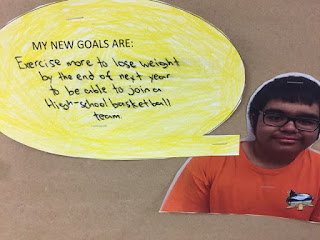I was very excited to teach healthy living this month because it aligns very closely with our health curriculum. Our county offers many resources to teach healthy living so I utilized some of those in our lessons.
We started the month by introducing the topic of healthy living and talking about some of its components. We made an anchor chart with the five parts of healthy living that we would be learning about - eating well, being fit, sleeping well, staying well, and avoiding alcohol and tobacco. The kids were already able to tell me a little bit about what they knew, which I added to the chart. Healthy living is emphasized in my county in all grade levels, so they had a lot of prior knowledge!

Looking at the chart, we shared some areas of healthy living that were strengths. Many kids said being fit was a strength because they exercised at recess, gym, and after-school sports. Staying well and avoiding getting sick was another strength for many kids. Next, we talked about areas for growth. Sleeping well was a big one. My kids tend to go to sleep late. After this discussion, each student wrote a SMART goal for themselves on the topic of healthy living. It was great to go back and review goal-setting, too! Here are some of their goals.


In the next lesson, we focused on eating healthy. I projected the food pyramid and we had a class discussion about what we noticed. The kids were surprised to see that soda and sweets were not even on the pyramid but were off to the side because they weren't supposed to be eaten everyday. Many of them did say that they ate the recommended number of fruits and vegetables a day, so that was good to hear. We talked about examples of food that would be found at each level of the pyramid. Then, students drew their own healthy eating plates. I showed them a model of how a healthy plate has certain amounts of fruits, vegetables, healthy grains, and proteins. The students then drew pictures of plates with what they would like to eat.


Next, we learned about being fit. I explained to the kids that the heart is a muscle, and we have to exercise to keep the blood flowing to the heart and to the work the muscle. Then, we talked about activities that we do everyday, and the kids had to decide if it was a physical activity that would work their heart, or not a physical activity. They were surprised to find that many of the activities that they do everyday, such as walking to school, are physical activities!
Then, the kids got into pairs and made posters encouraging other kids in the school to be fit.

The next lesson was all about avoiding alcohol and tobacco. We had already discussed alcohol briefly in the first lesson because the kids wanted to know why adults could drink it but they could not. I explained that kids' brains are still growing, so alcohol can affect how their brain continues to grow. In this lesson, I decided to focus on smoking, because smoking is bad for everyone, regardless of age. We read a book called "Smoking Stinks!" by Kim Gosselin. In the book, the main character Maddie, worries about her Grandpa Norman who is a smoker. She ends up doing a health report in class on smoking and learns all about the harmful side effects of smoking for both Grandpa Norman and people around him. After reading, we brainstormed some different ways the kids could say no if someone offered them a cigarette. Then, they illustrated a cartoon strip showing two different strategies they would use in that situation.


In our last lesson on healthy living, we talked about sleeping well. At the beginning of the week, I gave them a sleep log that asked them to think about what they ate the day before, how much exercise they had done, and how many hours they slept. This activity let us preview some math skills - we are actually going to be learning about elapsed time this upcoming week. Unfortunately, we were only able to keep the logs for three days instead of seven, but we still got some valuable information from them. I had the kids discuss what they noticed at their tables. The first thing they noticed was that kids who exercised during the day tended to fall asleep at a better time. They also noticed that when they slept 8-10 hours, they had more energy the next day.

Finally, we watched Alex's video. It was great for my kids to see how healthy living is crucial for an athlete. Her challenge was to write down 3-5 healthy choices they had made this month. My kids were all able to write down at least five and many chose to write more! They also added a picture showing themselves making healthy choices.





































